

My first visit to Lydiard Tregoze was in the fifth year at Sir Walter St John’s School in Battersea when a small party of us came on a visit with Mr Smallwood, a retired second master at the school who had an abiding interest in the history of the school which developed into a consuming interest in Lydiard.
The house and church were somewhat of a revelation to us situate as they were in the middle of nowhere. It was 1964 and they seemed forgotten by time. Frank Smallwood gave us a tour of the church particularly the monuments – we carefully noted a Viscount St. John of Battersea – and we particularly marvelled at the triptych – very carefully opened for us despite its fragile condition. We also viewed the empty house. All seemed sad though marvellous.
The passing 56 years have seen very much change. Swindon has arrived in the parish but the compensation has been the superb restoration both of church and the house and the expansion of the grounds restored to the house.
Lydiard’s sister church, St Mary Battersea, has been “my” church since 1964 and all around the church has also changed during that time. The flour mills built on the site of the St John manor house were in turn demolished and replaced by Sir Norman Foster flats but not before the foundations of the “H” shaped house were exposed to view in an archaeological study. The manor’s dower house was demolished in the 1970s and many other historic sites round the church have been replaced by flats.
However, the church remains. The east window by Van Linge, an heraldic tour de force to compliment Lydiard’s triptych and the east window remains and the various St John monuments have been recently cleaned and are (very) occasionally visited by a passing member of the family.
Battersea also has a friends’ organisation although much more modest than the Lydiard – mainly because the congregation itself has been able to promote and finance restoration of the building – seemingly a continuous task. It would be good though if we could enliven the Battersea friends to encourage interest in Lydiard. We have had visits to Lydiard in the past and have had the very special privilege of hosting a Lydiard AGM at the church at Battersea.
So, hopefully, as soon as the virus restrictions end (hopefully sooner rather than later) we can revive the connection and encourage a Battersea interest in Lydiard and admire the very profound achievement in preserving Lydiard House, church and park for future generations to discover and enjoy.